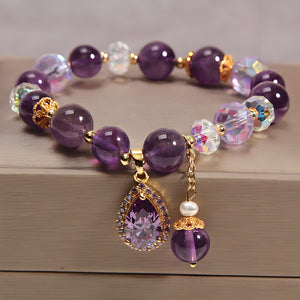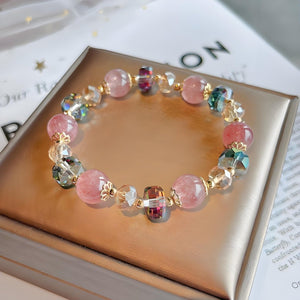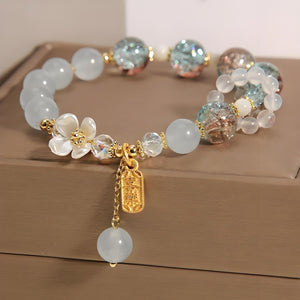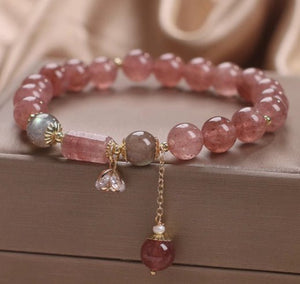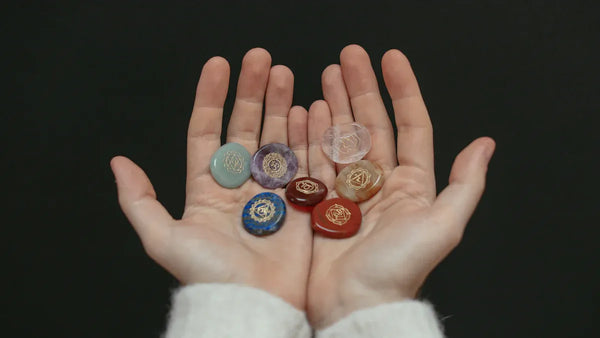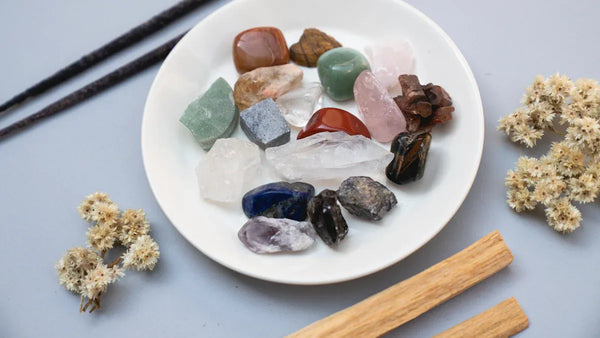
A lightning-struck jujube wood bracelet has beads from wood hit by lightning. Each bracelet has a Pixiu amulet. This amulet means protection and wealth in Chinese culture. People like this bracelet for its spiritual power and long history. The lightning marks and the Pixiu charm make each bracelet special.
Key Takeaways
Lightning-struck jujube wood bracelets are made from old trees. These trees were hit by lightning. Each bracelet is special because of burn marks and energy from the strike.
The Pixiu amulet on the bracelet stands for wealth and protection. It helps keep away bad spirits. It also brings good luck to the person wearing it.
These bracelets give spiritual protection and balance. They also bring positive energy. Many people use them for meditation, safety, and prosperity.
The beads are hand-carved. The packaging is eco-friendly. This shows respect for tradition and nature. It also makes each bracelet more valuable.
Buyers should look for real lightning marks on the beads. They should check for unique bead patterns. They should also look for cultural cards. This helps make sure the bracelet is real and meaningful.
What Is a Jujube Wood Bracelet?

Origins
A jujube wood bracelet is made from the jujube tree. This tree is strong and lives a long time. People in China have liked this tree for many years. They think it brings luck and helps people stay healthy. Craftsmen pick wood from old trees, sometimes over one hundred years old. The wood is hard and has a nice color, so it works well for beads.
Trees are important in many cultures. They grow tall and live for a long time. People think trees mean life and strength. In ancient Rome, trees hit by lightning were special. People built altars near these trees. They thought the trees could connect earth and sky. The jujube wood bracelet shows this respect for nature and history.
Lightning-Struck Wood
Lightning-struck wood is special in many beliefs. When lightning hits a tree, people think it is a sign from above. Some believe the power from the lightning stays in the wood. This idea is found in both Eastern and Western cultures. In China, Taoist and Buddhist groups use this wood for amulets. In Rome, people thought lightning-struck trees were holy and close to the gods.
Getting lightning-struck wood takes careful work. The table below shows how experts find and check this rare wood:
Aspect |
Description |
|---|---|
Sourcing |
Lightning-struck wood comes from trees that are still alive and have leaves after being hit. Trees like jujube, peach, willow, poplar, and jackfruit are used. The wood is hard to find because of rules and nature. |
Physical Identification |
Look for burn marks and broken branches from lightning. These signs help show if the wood is real lightning-struck wood. |
Energy Detection Induction |
People think the wood keeps 'lightning energy.' Some can feel heat or a cloth-like touch when they hold it, especially if they are sensitive. |
Thunder Pattern Recognition |
The wood has special thunder patterns. These are hard to see and need experts to find them. |
Verification |
Because it is tricky, only skilled people or psychics can tell if the wood is real by feeling its energy. |
Cultural Significance |
The wood is important in Taoist and Buddhist beliefs. It is used in bracelets to keep away bad spirits and bring good luck. |
People think lightning-struck wood links earth and sky for a short time. This makes the tree special. The wood often has burn marks and cool patterns. Some say it feels warm or gives a small shock when touched. These things make each jujube wood bracelet from lightning-struck wood one of a kind.
Many cultures think lightning is a tool of the gods.
Trees hit by lightning are seen as holy and are kept safe.
When lightning hits a tree, it is seen as a link between earth and heaven.
People believe bracelets from this wood protect and bring luck.
Stories and rituals make the wood even more special.
A jujube wood bracelet made from lightning-struck wood is both beautiful and meaningful. It stands for protection, energy, and a tie to old traditions.
Symbolism

Spiritual Meaning
Lightning-struck jujube wood is important in Chinese tradition. People think lightning hits the tree to fight evil spirits. The Thunder God splits the wood to keep away bad things. This wood is a strong talisman. Demons and ghosts are afraid of it. Many call it "evil-avoiding wood." It protects people and brings good luck.
The bracelet’s power comes from the wood and its symbols. Craftsmen carve Taoist symbols into the beads. Yin Yang and Bagua show balance and harmony. These symbols mean opposites can work together. Some bracelets have dragons. Dragons stand for luck, strength, and success. If you see a dragon and phoenix together, it means a happy marriage. It also means a good life.
Note: People believe lightning-struck jujube wood holds energy from the sky. This makes each bracelet special. It gives spiritual protection and balance.
People like these bracelets for more than their looks. They think the wood has sky energy. This energy protects against bad things. The bracelet stands for hope, wealth, health, and happiness. Families give these bracelets as gifts. They want to share blessings and protection.
-
Main meanings of lightning-struck jujube wood bracelets:
Works as a talisman to keep away evil and bring luck
Stands for spiritual protection and balance
Has symbols like Yin Yang and Bagua for harmony
Dragon and phoenix designs mean luck and happy marriage
Taoist taboo characters help remove bad energy
Pixiu Amulet
The Pixiu amulet is a famous symbol in China. Pixiu is called the "Wealth-Attracting Beast." This creature has a big mouth and no anus. It gathers money but never loses it. People believe Pixiu helps owners keep and get more money.
Pixiu is also a guardian. It keeps homes and people safe from evil and bad energy. In Feng Shui, families use Pixiu statues or jewelry for good luck. They hope for better jobs and family peace. Pixiu is often shown stepping on coins. This shows it brings and keeps wealth.
Period/Dynasty |
Rituals and Practices Involving Pixiu Amulets |
Key Texts/Manuals Referenced |
|---|---|---|
Warring States |
Pixiu is seen as a sky guardian. It fights evil and brings treasures. |
Shan Hai Jing (Classic of Mountains and Seas) |
Han Dynasty |
Pixiu is linked to rulers and wealth. Jade Pixiu amulets show Confucian ideas. |
Han Shu (Book of Han) |
Tang Dynasty |
Rules say Pixiu’s head should face out to get fortune. Used as a protective symbol. |
Tang-era geomantic lore, Buddhist and Daoist texts |
Ming Dynasty |
Pixiu amulets given to merchants and officials for wealth and safety. Jade carving skills are explained. |
Ming Shi Lu, Tiangong Kaiwu |
Qing Dynasty |
Rituals include moonlight bathing and incense. Wear Pixiu bracelet on left wrist for wealth energy. |
Qing Imperial Archives, Yangzhai Biao Zhun |
Modern Times |
Cleansing rituals and special placement still happen. Pixiu bracelets are still popular. |
Contemporary Feng Shui manuals |
-
Main ideas about the Pixiu amulet:
Brings and keeps wealth for the owner
Keeps away evil spirits and bad energy
Gives good luck, job success, and family peace
Needs to be blessed to work well
Used in rituals from old times to now
A jujube wood bracelet with a Pixiu charm is very special. The wood gives spiritual protection and balance. The Pixiu brings wealth and keeps away harm. Together, they make a strong talisman. Many people trust it for both spiritual and real-life help.
Features

Unique Marks
Lightning-struck jujube wood bracelets have special marks. Each bead has lightning patterns. These look like lines burned into the wood. The marks come from lightning energy. No two beads are the same. Some beads are shaped a little differently. Others have different colors or textures. These features do not mean the beads are bad. They show how the wood changed over time.
The beads are about 8x9mm in size. Craftsmen pick wood from old jujube trees in Shandong, China. The lightning marks and wood grain make each bracelet unique. People can see and feel these differences. The wood feels warm and smooth to touch. The bracelet holds history and energy.
Tip: Look for beads with burn marks and thunder patterns. These signs help you find real lightning-struck wood.
Craftsmanship
Artisans carve each bead by hand. They use old methods to shape and polish the wood. This work needs skill and patience. Craftsmen focus on every detail. They keep the wood’s grain and lightning marks clear. Each bracelet has 22 beads. The beads are strung to fit well on your wrist.
The Pixiu charm is also carved by hand. It adds meaning and beauty to the bracelet. The wood and Pixiu together make a strong talisman.
The bracelet comes in packaging that is good for the earth. Makers use materials that do not harm nature. Each package has a card. The card tells the story of Pixiu and the lightning-struck wood. This makes the bracelet a nice gift.
Feature |
Description |
|---|---|
Bead Size |
8x9mm, 22 beads per bracelet |
Material Origin |
Century-old jujube tree from Shandong, China |
Crafting Method |
Hand-carved, traditional techniques |
Unique Patterns |
Natural lightning marks, grain variations |
Packaging |
Eco-friendly, includes cultural card |
The bracelet shows nature’s power and human skill. Each one stands for tradition, energy, and care.
Benefits
Protection
Lightning-struck jujube wood bracelets give strong protection. Many people think the wood has sky power. This power helps stop bad energy. The Pixiu charm adds more safety. In Chinese tradition, Pixiu keeps away evil spirits and bad luck. People wear these bracelets to feel safe every day.
Tip: Most people wear the bracelet on the left wrist. Many think this side gets the most protective energy.
Some families give these bracelets to kids or travelers. They hope the bracelet keeps loved ones safe. The lightning marks make each bead a shield. The bracelet acts like a wall against harm.
Prosperity
The Pixiu amulet stands for wealth and good luck. In Feng Shui, Pixiu brings money and keeps it safe. Business owners and students often wear the bracelet for better luck. They hope to do well at work or in school.
-
Ways the bracelet supports prosperity:
Pixiu gathers wealth and keeps it safe.
The bracelet brings luck in business and tests.
Many believe it helps with job promotions.
A table below shows who wears the bracelet for prosperity:
Group |
Reason for Wearing |
|---|---|
Businesspeople |
Attract more clients and profits |
Students |
Improve focus and grades |
Workers |
Seek promotions and raises |
Positive Energy
The bracelet also gives positive energy. Lightning-struck wood has a special force. Many say it feels warm or calm. The beads help balance feelings and clear the mind. People use the bracelet when they meditate or pray.
Note: Some people feel more relaxed and focused with the bracelet.
The bracelet’s energy can lift your mood. It helps people feel hopeful and strong. Wearing it reminds many to stay positive and open to good things.
Authenticity

Identifying Genuine Bracelets
People who collect these bracelets want to know if they are real. Real bracelets have lightning marks that look like burned lines or scars. Each bead has its own special pattern. No two beads are the same. The wood feels smooth and warm when you touch it. The color comes from the tree, not from paint or chemicals.
Fake bracelets try to look real but are not. Some sellers use other woods like ebony or sandalwood. They might dye the wood or make fake burn marks with tools. Some even use paint or chemicals to change how the wood looks. If a bracelet is very cheap or sold in big groups, it might be fake. Buyers should look for these clues before buying.
Tip: Ask for close-up pictures of the beads. Check for real wood grain and lightning marks, not painted lines.
Tips for Buyers
Smart buyers ask questions before they buy a jujube wood bracelet. They should ask for a cultural card. This card tells the story of the wood and Pixiu charm. It helps prove where the bracelet comes from. Buyers should also look at the packaging. Eco-friendly packaging shows care and respect for tradition.
The table below shows what buyers should check:
What to Check |
Why It Matters |
|---|---|
Natural lightning marks |
Shows the wood is truly lightning-struck |
Unique bead patterns |
Proves each bead is one-of-a-kind |
Cultural card included |
Confirms the story and tradition |
Eco-friendly packaging |
Reflects respect for nature |
Seller reputation |
Trusted sellers offer real products |
Buyers should not pick bracelets with perfect or matching beads. Real beads have small differences. They should also be careful with sellers who do not give details or proof. Asking questions helps buyers find a bracelet with real meaning and history.
The jujube wood bracelet comes from old traditions.
Talented workers carve Taoist symbols into the beads.
Symbols like Yin Yang and Bagua help protect people.
The lightning-struck wood has strong energy.
Each bracelet is different because of this rare wood.
This jewelry is a sign of safety and wealth. Many people wear it for balance and luck. They also want to feel close to Taoist ideas.
FAQ
What makes lightning-struck jujube wood special?
Lightning-struck jujube wood has a special energy. People think lightning gives the wood spiritual power. The marks on each bead show the tree’s story and its link to nature.
How should someone wear the Pixiu amulet bracelet?
Most people put the bracelet on their left wrist. This side is believed to bring protection and wealth. The Pixiu charm should point outward to bring good luck.
Can the bracelet help with meditation or relaxation?
Many people say the bracelet helps them feel calm. The wood’s energy and the Pixiu charm help with meditation and positive thoughts.
How can buyers check if a bracelet is authentic?
Buyers should look for real lightning marks and different bead patterns. A cultural card and earth-friendly packaging help prove it is real. Good sellers show close-up pictures and give clear details.
